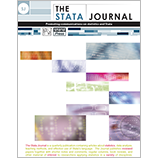A command to calculate age-standardized rates with efficient interval estimation
Dario Consonni
Epidemiology Unit
Fondazione IRCCS Ca' Granda–Ospedale Maggiore Policlinico
Milan, Italy
[email protected]
|
Enzo Coviello
Statistics and Epidemiology Unit, ASL BT
Barletta, Italy
[email protected]
|
Carlotta Buzzoni
Clinical and Descriptive Epidemiology Unit, ISPO
Firenze, Italy
[email protected]
|
Carolina Mensi
Department of Preventive Medicine
Fondazione IRCCS Ca' Granda–Ospedale Maggiore Policlinico
and
Lombardy Mesothelioma and Sinonasal Cancer Registry
Milan, Italy
[email protected]
|
Abstract. In this article, we illustrate the command distrate, which calculates
age-standardized rates with efficient interval estimation by using formulas
developed by Tiwari, Clegg, and Zou (2006, Statistical Methods in Medical Research
15: 547–569) as a modification of the method proposed by Fay and Feuer
(1997, Statistics in Medicine 16: 791–801). This method is currently used in
the Surveillance, Epidemiology, and End Results Program of the National Cancer
Institute in Bethesda, Maryland; the Italian Association of Cancer Registries
(Associazione Italiana Registro Tumori, AIRTUM); and the Lombardy Mesothelioma
and Sinonasal Cancer Registry in Northern Italy. The command produces
a compact output and allows for the possibility of specifying a rate multiplier, for
instance, ×100,000 or ×1,000,000. Furthermore, rates and confidence limits can
be easily exported to an external dataset for further processing (for example, for
making graphs). The command distrate is a useful addition to the official Stata
command dstdize.
View all articles by these authors:
Dario Consonni, Enzo Coviello, Carlotta Buzzoni, Carolina Mensi
View all articles with these keywords:
distrate, confounding, standardization, incidence rates, mortality rates, confidence intervals
Download citation: BibTeX RIS
Download citation and abstract: BibTeX RIS
|
